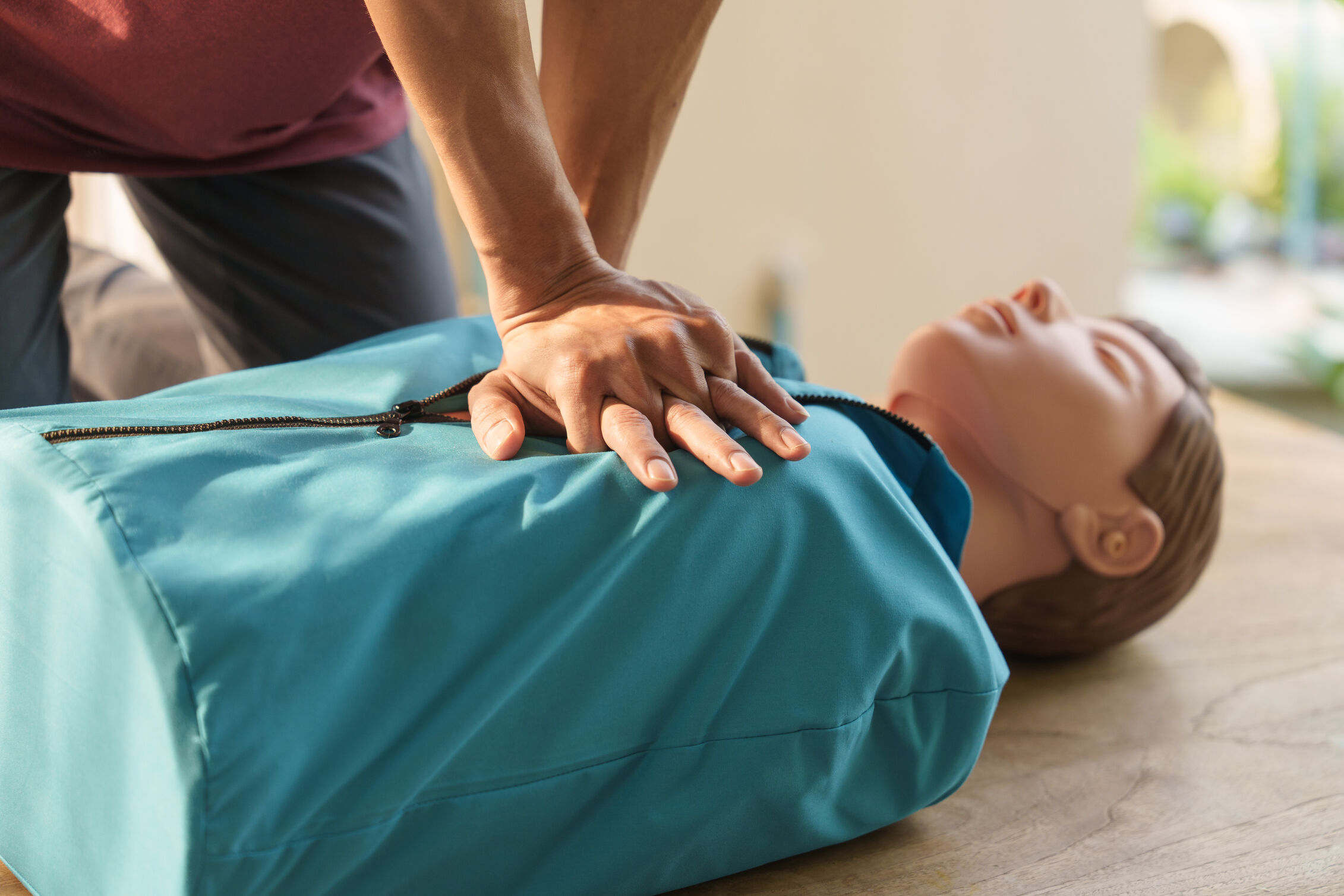Exploring Pediatric BLS Guidelines 2025

Sudden cardiac arrest (SCA) is rare in children, impacting approximately 3/100,000 young people each year in the United States. While 50% of these cases remain unexplained, the other half are the result of congenital and genetic defects that require the attention of specialized multidisciplinary teams of healthcare professionals.
One of the most effective tools any healthcare professional can have in their toolbox when it comes to pediatric resuscitation is a strong BLS skill set. Frontline workers and pediatric specialists update these skills regularly, and online coursework for BLS recertifications and PALS makes it easier than ever to maintain these lifesaving skills.
Most importantly, physicians, advanced practice providers, nurses, and clinical support staff who work with pediatric patients should all be familiar with the latest pediatric BLS guidelines (2025). Here are the latest recommendations based on research and experience in the field.
Causes of Pediatric Cardiac Arrest
The management of pediatric patients in cardiac arrest begins with an appreciable awareness of potential causes. Children are not simply small adults; they have unique physiologies that change rapidly based on age and their unique genetics. And while sudden cardiac arrest is not common among young people, there are two primary causes healthcare workers should be prepared to encounter.
Respiratory Origin
Respiratory-driven or asphyxial arrest is the most common type of cardiac arrest in infants and children. This type results from a progressive lack of oxygen and acidosis due to respiratory failure and shock. Causes of respiratory failure can include but are not limited to hypotension leading to reduced cardiac output, sepsis, airway obstruction, pneumonia, sudden infant death syndrome (SIDS), and metabolic abnormalities.
Cardiac Origin
Sudden cardiac arrest can also be caused by the development of a lethal arrhythmia like ventricular fibrillation (VF) or ventricular tachycardia (VT). While less common in infants and children than in adults, causes of these arrhythmias can include myocarditis, congenital electrical abnormalities, toxic ingestion, or a sudden blow to the chest.
The PALS and BLS Approach to Cardiac Emergencies
Resuscitation science has established incredibly effective yet simple guidelines for the care of pediatric patients in distress. Implementing these guidelines takes little more than time and effort to familiarize yourself with each of the steps needed to optimize your patient's outcome.
1. Scene Safety
Before taking any action, every health professional needs to make sure the scene is safe. Without confirmation of scene safety, a rescuer may end up as another victim who potentially endangers others. This means paying attention to the potential for environmental risk factors that can cause you harm, and accessing the patient or moving the patient must be done only when safe.
2. Responsiveness
To check for responsiveness in a pediatric patient, gently tap or shake the child while speaking loudly and clearly, asking, "Are you okay?" or saying their name. When doing this, observe for any eye movement, verbal response, or body movement. If the patient is unresponsive and you’re alone, shout for nearby help and activate emergency medical services (EMS). If you’re not alone, one rescuer can continue to care for the patient while a second activates EMS and retrieves an automated external defibrillator (AED).
3. Check Breathing and Pulse
If the patient is unresponsive, the next step is to check for breathing while simultaneously searching for a pulse. According to current pediatric BLS guidelines (2025), while observing the child’s chest for movement, try to palpate a central pulse (brachial pulse in an infant; carotid or femoral pulse in a child) but not for longer than 10 seconds. If the patient isn’t breathing and there is no pulse, you must take action:
- Single rescuer: For an unwitnessed, sudden collapse, the rescuer should start CPR with a ratio of 30 compressions to 2 breaths. After about two minutes, if still alone, activate EMS and retrieve an AED. For a witnessed collapse, the rescuer should activate EMS and retrieve an AED. The single rescuer should use the AED as soon as it is available. If the AED is not nearby or not available, start CPR while awaiting EMS arrival.
- Two or more rescuers: compressions should begin at a ratio of 15 compressions to 2 breaths in infants and children. Chest compressions should always be accompanied by ventilation for infants and children who remain pulseless after the initial sequence of compressions.
High-quality CPR is critical to supporting an optimal outcome. When delivering a breath, the rescuer must take note of the chest rise in the patient. This ensures enough air is entering the patient's lungs. Putting too much air into a child’s chest can work against you. If you see their chest rise, that is enough air.
Effective chest compressions are also critical to survival. Significant criteria for chest compressions include:
- The chest should be depressed at least one-third of its anterior-posterior diameter with each compression. Infants: approximately 4 cm (1.5 inches), children: 5 cm (2 inches), and adolescents: 5 to 6 cm.
- The optimum rate of compressions is approximately 100-120 per minute.
- The sternum should return briefly to its normal position at the end of each compression, allowing the chest to recoil fully and the chambers of the heart to fill.
- A smooth compression-decompression rhythm, with minimal interruptions, is key.
4. Apply the AED
With high-quality CPR in progress, getting the AED to the child as quickly as possible is most important. Automated External Defibrillators are designed to walk the rescuer through the process. By following the prompts offered by the device, the patient's rhythm will be analyzed, possibly resulting in a shock to be delivered.
If a shock is delivered, the rescuers should immediately resume CPR, and if the device indicates a non-shockable rhythm, CPR should also be immediately resumed. The relationship of CPR to potential shocks operates on a continuous 2-minute cycle until advanced life support arrives. After two minutes of CPR, the patient should be analyzed, instructions should be followed, and CPR should resume.
The Advantages of PALS Training vs BLS
BLS training covers basic strategies for managing cardiac emergencies involving infants and children, but it is generally designed for people over the age of 12. Healthcare professionals who add PALS certification have advanced knowledge and skills for treating pediatric patients, including:
- Familiarity with pediatric respiration tools and medications
- Management of psychological trauma associated with pediatric emergencies
- A thorough understanding of the Pediatric Assessment Triangle
- Common complications affecting pediatric health emergencies
- Advanced team dynamics
While PALS training is not required for every healthcare worker, it is typically a professional obligation for nurses and doctors who work in emergency settings, intensive care units, and roles that involve constant contact with pediatric patients.
Pediatric BLS Guidelines (2025) Save Lives
BLS guidelines set the foundation for success in resuscitation. Uncomplicated steps of sequenced actions based on best practices in resuscitation are direct and goal-oriented, and familiarizing yourself with the latest pediatric BLS guidelines (2025) means you’ll be in a position to save lives in emergency situations.
Premiere is committed to ensuring that all healthcare professionals have access to comprehensive and current BLS certification and PALS training through efficient and effective online coursework. These guidelines can be implemented by healthcare professionals of any role and level of training and make it easy to access these critical skills.
All of Premiere’s award-winning courses are created by industry professionals and reflect the latest scientific and experience-based best practices. Whether it’s pediatric BLS training or any other required continuing education credits, you’ll be able to fulfill all your professional obligations and advance your career on a timeline that matches your busy schedule.
Latest Posts


.png)
.jpeg)


